History of the St Helen's Church Building
The Early Church at Trowell
St Helen’s Church,Trowell is a Grade 2 star listed building which has been on the site for many hundreds of years. In fact the first recorded reference to it may be found in the annals of York Minster, where it states that “An application was made by the Lord of the Manor in Trowell, for a Church to be established, at the request of the people.” Trowell was then probably a Saxon settlement.
Permission was granted in 801, which means that a Church may have been on this site for over 1200 years. Traces of the Saxon church are reputed to have been found under the chancel when the floor was raised up around 1905. The next reference to the church is in the Domesday Book which quotes “Here is a priest and half a church and six acres of meadow”. This was valued in the Confessor’s time (1046) at 100 shillings; but in the Conqueror’s time when the Domesday Book was written (1080) at 20 shillings.
Note: The reference to “a priest and half a church” means that it was shared with another parish; in the case of Trowell, this was Cossall and the Rectors of Trowell received half the tythes of Cossall; this continued until they were commuted in 1787.
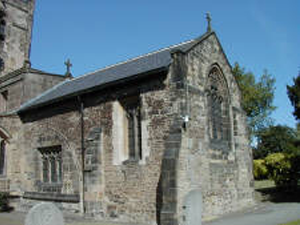
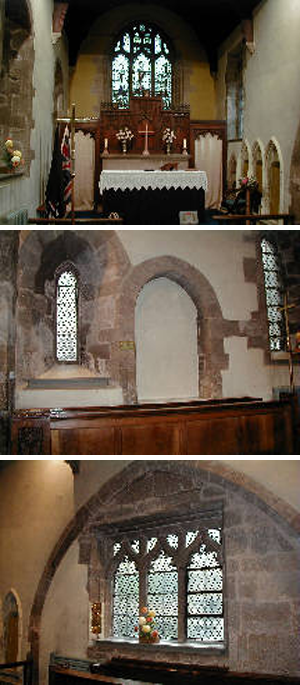
Chancel
The present chancel dates back to 1180, which is a very early example of Early English architecture, the fabric consisting of untrimmed masonry in thin courses. By this date Trowell was a well developed parish with a population of fifty.
The lancet windows, filled-in priest’s door, and a filled in archway which was to an earlier side chapel can be seen in these pictures.
The piscina, credence, and sedilia also date from this earlier period.
A piscina is a small niche which was used to hold a bowl of water where the priest washed his hands during a service of communion (also called mass).
The credence shelf is another small niche with a shelf on which were placed the bread and wine used during the communion.
The sedilia are a group of three seats on the south wall of the sanctury in which the clergy would sit during high mass.
The church was originally Roman Catholic like all of the other churches in England but became Protestant when Henry VIII separated from the Pope and became head of the Church of England.
The windows in the south wall are of Perpendicular insertion.
Until 1890 the east window contained painted glass, which was replaced with a stained glass window by Kemp. This window is dedicated in memory of the Revd Robert John Hodgkinson 1888-90. A reredos was erected three feet from the east wall to allow the priest to have room to robe up. A new altar table, altar rail, new oak choir seats and chancel screen were introduced and the chancel floor raised at the 1890 restoration. In the Robert Thoroton Histories, it is stated that the chancel had contained monuments which had been mutilated during the Puritan period, but by early in the 19th century they had been removed.
When William Stretton of Lenton visited St. Helen’s in 1818, he describes the east window – of five lights in two storeys which had been beautifully ornamented with painted glass of a superior kind, fragments of which still remain, a label to a mutilated figure is inscribed ‘EDW T REX’. He describes the chancel floor as being bad, and the Priest’s door was still in place.
Nave
The nave and side aisles were added in the 14th century and were built in Trowell sandstone; the arcade of three arches each side of the nave are also of this date. The walls were raised in the 15th century and three two-light clerestory windows inserted each side. The square headed windows on the outer walls of the aisles are of interest since they are only to be found in parts of Nottinghamshire and Derbyshire.
The pulpit only dates back to the 1891 restoration and replaced “a quaint old wooden pulpit bearing the date 1667”.
The memorial window at the east end of the north aisle is in memory of the men of Trowell who died in the 1939 – 45 war and the stained glass window on the east side of the south aisle is in memory of the son of a Rector of Trowell, the Revd E. J. R. Nichols, who was killed in the Great War 1914 – 1918.
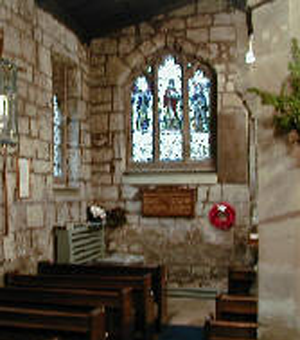
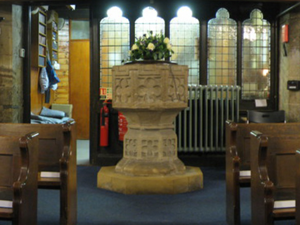
Font
The font is a large 14th century octagonal font with a quatrefoil in each panel, an embattled edge and also quatrefoils around the base.
Porch
The 14th century porch retains the stone vault supported by four arch ribs on either side, but restoration work during the last 150 years has taken away most of its ancient characteristics.
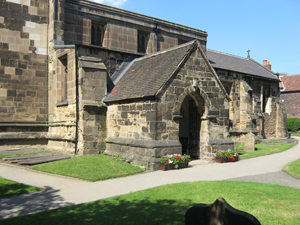

Tower & Bells
The tower, completed in 1480, is also built entirely of Trowell sandstone, and is a two-staged embattled tower.
From 1480 to 1792 there were only three bells in the tower, but in 1792 six bells were cast by Taylors of Loughborough and fitted. In 1931 the bells were re-cast, again by Taylors. The bells range in size from 2’1″ to 3’0″ (63 – 91.5cm) in diameter and 3.64 to 9.25cwts (185 – 470kg). Each bell carries an inscription which was reproduced when the bells were re-cast.
The top of the tower, which is reached by a steep spiral staircase, gives fantastic views of the area on a fine day.
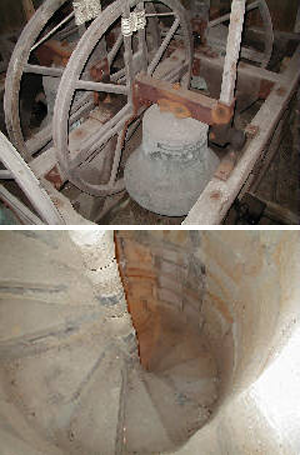
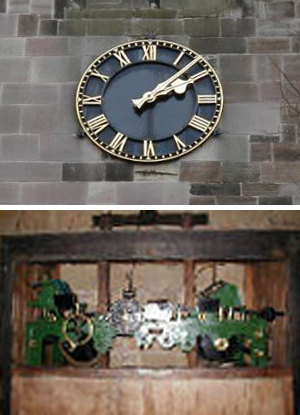
Clock
In 1927 the old Nottingham Exchange clock was placed in the tower at the expense of Mr. S. P. Derbyshire as a memorial to his grandparents who had lived in the house immediately to the east of the church. (The old Rectory House of the First Mediety). The clock was hand-wound until the early 1970’s when an electric motor was fitted. This was in turn replaced by a modern self correcting motor system during maintenance in 2017.
Organ
The organ was presented by the late Mr William Smith (founder of the local firm of corn millers) in 1900. The organ was originally worked by hand, a person behind the organ in the ringing chamber operated a lever to pump the bellows.
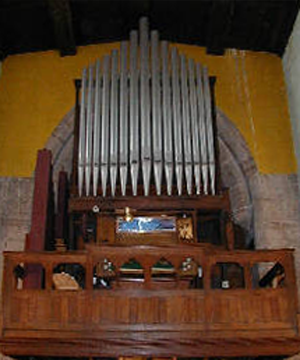
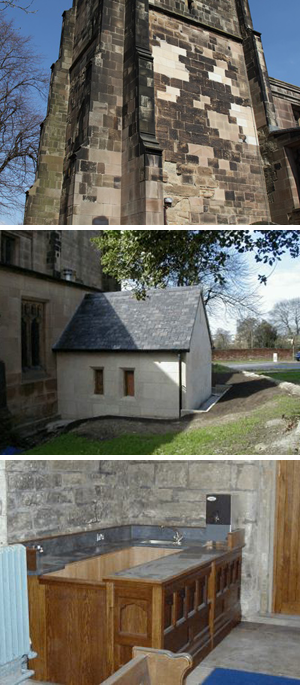
Restoration
From time to time the church has been extensively restored. In 1835 at the expense of Lord Middleton, all the old painted glass which contained fragments of the Brinsley and Strelley coat of arms was taken out; all tracery and mullions were cut out of the nave and aisle windows, and the walls were thickly plastered. This covered up The Commandments, Lord’s Prayer and Creed, painted in 1777 by Samuel Pinkney, then Churchwarden. The flat oak roof was lathed and plastered.
Further restoration work in 1890, involved new roofs for both chancel and nave, the plaster was removed from the nave, the windows restored and oak pews were fitted in the nave. A choir vestry was formed in the lower part of the tower beneath a ringing chamber which was raised some nine feet above the vestry floor.
Restoration re-commenced in 1956, this work consisted of replacing some of the outside face of the nave and the tower walls with Derbyshire gritstone. This work will need to continue until all the Trowell sandstone has been covered.
Toilet Extension and Tea Bar
After lengthy negotiations with English Heritage, the Southwell Diocese Advisory Committee and Broxtowe Borough Council Planning Department, permission was obtained in 1999 to build a small extension to the Church building. The plans included a porch like structure on the north side to house a toilet facility and provision of a tea-bar in the north-west corner.
It took a lot of fund raising (in the region of £37,000) but we were able to start using the toilet on 20th May 2001. The Tea Bar was completed and in use by March 2002.
War Memorial
The new War Memorial was dedicated at Trowell Church during the Remembrance Day morning service on 13th November 2011. It had been erected as a result of popular demand, with notable support from Councillor Ken Rigby and the Borough and Parish Councils.
Monuments
The church contains only one ancient monument and that is to the memory of William Hacker who was buried under the altar on 22nd December 1668. The Latin inscription describes him as “a most obedient son of the Church of England. He was the light and pillar of Trowell whilst he lived.”
His nephew was the Colonel Francis Hacker who was convicted of high treason and hanged as a traitor at Tyburn. Other members of the Hacker family are buried in the south aisle of the nave.
Various other plaques and brasses recording burials in the church are located on the walls and floor. One commemorating the Reverend Tristram Exley who died in 1792 and who is buried in the chancel, was hidden behind the reredos but is now visible.
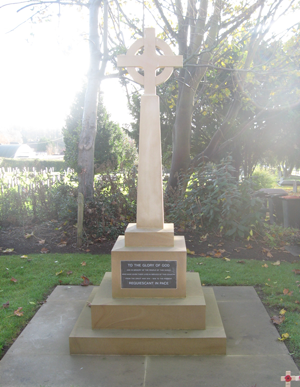
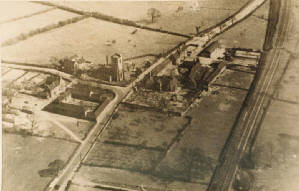
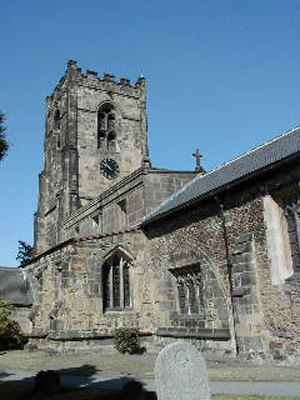
Trowell Benefice
Records show that the patronage was originally held by William Peverel from the time of the Conquest until 1241, when the Convent of Sempringham became patron. The patronage was taken over by the Crown in 1550, following the dissolution of the monasteries at the time of Henry VIII. The Crown remained patron until 1588, when the Willoughby family purchased the patronage.
In 1259 the Brinsley family applied for a dispensation to hold an additional “Benefice with cure of souls”. From then on Trowell Church came under two Patrons and two Rectors. The two halves were called the First Mediety and the Second Mediety. The Crown remained patron of the First Mediety and the Brinsley family were patrons of the Second Mediety. (In some records the name Brinsley is spelt Brunnesley).
The Brinsley family held the patronage of the Second Mediety until it was purchased by the Hacker family in 1602. The First Mediety remained with the Willoughby family until 1724 when Lord Middleton became Patron. Lord Middleton then became Patron of the whole church in 1787, when the two halves were re-united.
The Parish Registers (now archived) do not begin until 1570 but it is obvious that some leaves must be missing as the statement on the flyleaf quotes 1558. The Register is of parchment and on the flyleaf is written:
“In this booke, is contayned the names of those that have been maride, babtissed and buried from the firste year of the reigne of the Queenes moste excellent Majestie Elizabethe, by the grace of God of England and France. The Queene, defender of the faythe, etc. untyll this present, beinge the fortythe of her graces Raigne and the year of our lord god 1598” – Nicholas Hallam, Thomas Slacke Rectors
The date 1598 would be that in which the present register was transcribed from the original paper book.
St. Helen’s Today
The picture on the left shows evidence of changes through time:
- 1180 – Chancel, Archway to side chapel
- C14 – Nave
- C15 – Nave walls raised
- 1480 – Tower
- 1914-18 – Memorial window
- 1927 – Clock
- 1956 – Stonework restoration
- 1999 – Chancel re-roofed in Welsh slate
Alan J Cook – December 1999 | Photographs by Joan & Don Whysall
St Helen's Renewal Project
We are delighted that our plans to enable St Helen’s to better serve the church and community were considered very positively by the Diocese and other planning authorities. Following a long process of thought, prayer, consultation and reflection as we sought God’s inspiration as to how we can best serve in looking to the future, work was undertaken to modernise and to improve the comfort, assessibility and flexibilty of the building.
To find out more about the project and to view photographs of the transformation, click here.
List of Rectors of Trowell
Patronage
Records show that the patronage was originally held by William Peverel from the time of the Conquest until 1241, when the Convent of Sempringham became patron. The patronage was taken over by the Crown in 1550, following the dissolution of the monasteries at the time of Henry VIII. The Crown remained patron until 1588, when the Willoughby family purchased the patronage.
In 1259 the Brinsley family applied for a dispensation to hold an additional “Benefice with cure of souls”. From then on Trowell Church came under two Patrons and two Rectors. The two halves were called the First Mediety and the Second Mediety. The Crown remained patron of the First Mediety and the Brinsley family were patrons of the Second Mediety. (In some records the name Brinsley is spelt Brunnesley.)
The Churches United in 1787 and Lord Middleton became patron of the whole church.
In the lists below, patrons are shown in bold.
Research: Don Wysall
1200 / 1300
| Rectors of the First Mediety | Rectors of the Second Mediety | ||
| Patron: William Peverel: Convent of Sempringham | Patron: Brinsley family | ||
| September 1241 | Gilbert de Bridesall | January 1259/60 | Richard de Trowell |
| April 1283 | Benedict de Rengesdone | May 1300 | Thomas de Stapelford |
| June 1302 | John de Laushulle | November 1310 | Robert de Brunnesley |
| August 1313 | John de Trowell | September 1349 | John de Brampcote |
| July 1327 | Richard de Kirkeby | September 1365 | John de Aldesworth |
| November 1331 | Adam de Lousill | October 1378 | John Fityll |
| January 1333/4 | Edward de Stapilford | John Carter | |
| August 1347 | Simon de Bradewell | ||
| July 1349 | Robert Broun | ||
| William de Prestwod | |||
| June 1373 | John de Stowe | ||
| February 1383/4 | William de Tanfeld | ||
1400
| Rectors of the First Mediety | Rectors of the Second Mediety | ||
| Patron: William Peverel: Convent of Sempringham | Patron: Brinsley family | ||
| February 1425/6 | William Parker | November 1416 | Thomas de Derley |
| 1444 | William Tull | October 1418 | John Cumberton |
| June 1463 | Richard Schoter | May 1438 | William Clerk |
| February 1476/7 | John Bakhows | November 1450 | Richard Burton |
| April 1461 | John Birnelay | ||
| October 1463 | Henry Fyppe | ||
| January 1473/4 | Christopher Clerkson | ||
1500
| Rectors of the First Mediety | Rectors of the Second Mediety | ||
| Patron: William Peverel: Convent of Sempringham | Patron: Brinsley family | ||
| June 1524 | Oliver Rigby | October 1506 | Geffrey Brynnesley |
| October 1542 | Peter Richardson | November 1507 | Robert Roo |
| Patron: The Crown | December 1522 | Maurice Cam | |
| March 1550/1 | William Redde | June 1554 | Peter Mudde |
| October 1552 | John Houghton | 1577 | Thomas Huchenson |
| June 1554 | Roger Page | March 1577/8 | Henry James |
| September 1556 | Richard Barlowe | June 1579 | Thomas Slacke |
| June 1566 | John Steele | ||
| Patron: Willoughby family | |||
| August 1558 | Nicholas Hallam | ||
1600
| Rectors of the First Mediety | Rectors of the Second Mediety | ||
| Patron: Willoughby family | Patron: Hacker family | ||
| April 1626 | Francis Hill | March 1601/2 | John Kyrkbie |
| July 1646 | Henry Denham | January 1646/7 | Robert Morris |
| John Leeke | 1650 | Nicholas Clarke | |
| January 1661/2 | William Parker | February 1671/5 | John Fox |
| April 1683 | Thomas Muston | ||
| June 1689 | John Dand | ||
1700
| Rectors of the First Mediety | Rectors of the Second Mediety | ||
| Patron: Willoughby family | Patron: Hacker family | ||
| May 1707 | William Paul | May 1700 | Hacker Brough |
| March 1709 | William John Dand | July 1710 | John Proudman |
| Patron: Lord Middleton | August 1719 | Henry Franceys | |
| July 1724 | John White | May 1746 | Richard Hardy |
| November 1742 | George Staunton Brough | July 1753 | Tristram Exley |
| December 1766 | Isaac Pickthall | ||
Rectors of the whole Church:
Patron: Lord Middleton
| 1792 | Isaac Pickthall |
| 13 June 1798 | George Sanders |
1800
Rectors of the whole Church (continued):
Patron: Lord Middleton
| 14 April 1838 | Francis Hewgill, MA |
| 30 April 1858 | Charles Walter Hudson, LLB DCL |
| 23 November 1877 | Hugh St Maur Willoughby, BA |
| 19 May 1888 | Robert John Hodgkinson, MA |
| 20 September 1890 | Hon William Byron, MA SCL |
| 28 May 1892 | Wray William Mills Hunt, BA |
| 8 November 1897 | William Henry McKennal Caldwell, BA |
1900
Rectors of the whole Church (continued):
Patron: Lord Middleton
| 23 January 1901 | James Dawson Lewis, MA |
| 15 March 1906 | Edward Richard Jeffreys Nicolls, MA |
| 18 August 1919 | Alyn Arthur Guest-Williams, MA |
| 8 October 1926 | Godfrey Michael Vincent Hickey, BA |
| 7 November 1942 | John Angles Barber, MBC BA |
| 24 March 1953 | Kenneth William Jones, BA |
| 17 September 1958 | Leslie Leonard Abbott |
| 10 September 1962 | John Matthews Syson |
| 29 November 1963 | Robert Daniel Fryer, LTh |
| 7 January 1972 | Arthur Marchshall |
| 3 November 1978 | Brian Cecil Walker |
| 7 June 1990 | Trevor Hatton, BA |
| 4 November 1996 | Graham Richard Booth |
2000
Rectors of the whole Church (continued):
Patron: Lord Middleton
| 2 October 2006 | Andrew Michael Lord, MA PhD |
| 28 July 2019 | Interregnum |